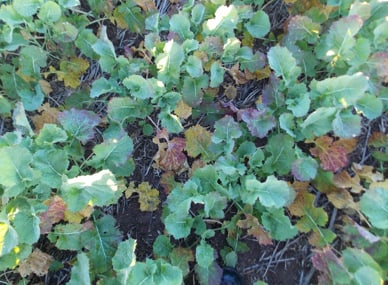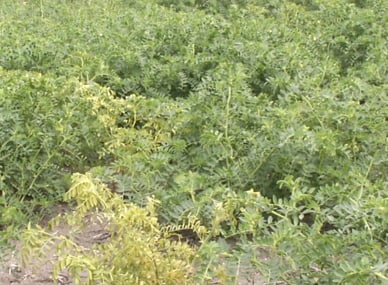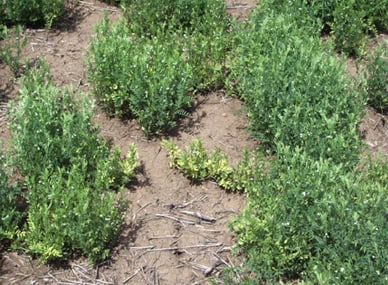Turnip yellows virus
Turnip yellows virus (TuYV) belongs to the family Luteoviridae, genus Polerovirus. TuYV is a phloem limited virus transmitted persistently by many aphid species, but the green peach aphid is the most important vector in Australia.
It is not transmitted mechanically or through seed.
It is an economically important virus of canola, forage brassica and temperate pulses (chickpea, field pea and lentil) (Aftab et al 2016, 2017).
A wide-spread infection of TuYV in canola crops was detected in South Australia, Victoria and New South Wales in 2014 (Aftab et al 2015).
What to look for
The general symptoms of TuYV infection are leaf distortion along with purple, red or yellow leaf discoloration, and stunting is common with early infection.






Typical symptoms of TuYV infection in specific crop types are:
- yellow, red and purple leaf discoloration (Figures 1-3) in canola and forage brassica (a number of canola varieties can be symptomless carriers of TuYV)
- pale, chlorotic leaves and stunting in Kabuli chickpeas (Figure 4)
- purple or red leaf discoloration in Desi chickpeas
- yellowing of the whole plant and stunting in field peas (Figure 5)
- yellowing on lower and middle leaves and stunting in lentils (Figure 6)
- leaf yellowing, tip necrosis and stunting in faba beans
- TIP necrosisof lupin plant
- systemic leaf reddening in subterranean clover
- yellow and purple leaf discoloration and the whole plant becomes yellow in bifora
- chlorotic leaf distortion in wild radish
- red or chlorotic leaves in musk week
- reddening of top leaves in three-horned bedstraw.
Disease cycle
The virus oversummers in perennial weeds, forage brassica and self-sown crops. The aphids will remain infective throughout their life but require a suitable host to survive between seasons.
Once a plant is infected with a virus it cannot be cured.
Economic importance
Over the last 10 years, TuYV has emerged as an important virus disease in grain and oilseed crops in southern Australia. Virus incidence is driven by climatic conditions and can be high, especially in canola and some pulse crops (Aftab et al 2018).
Currently, all canola varieties and hybrids are susceptible to TuYV. Up to 75% yield loss was observed in canola during the TuYV outbreak in 2014 (Coutts et al 2015).
In Western Australia, experimental plots of canola with up to 96% TuYV infection showed yield losses of up to 46% (Jones et al 2007). In UK, TuYV infection in canola caused yield losses which ranged between 43.3% and 80% (Dewar et al 2011).
Host range
Turnip yellows virus (TuYV) has a wide host range and is distributed worldwide, most temperate pulses, canola and forage brassica crops grown in southern Australia are susceptible.
Pulse hosts include:
- chickpea
- lentil
- field pea
- faba bean
- lupin and vetch.
Clovers, medic pastures and many common weeds such as marshmallow, bifora, musk weed, barrel medic and three-horned bedstraw are also hosts of TuYV (Freeman and Aftab 2011).
Management
- Control of weeds and self-sown volunteer crop plants that might harbour aphids and virus between cropping seasons.
- Rotation of canola and pulses with cereal crops to break the infection cycle.
- Sowing canola and pulse crops in cereal standing stubble can limit aphid colonization and hence virus spread.
- Sowing insecticide-treated seed to prevent early aphid colonization can reduce virus infection.
- Removing virus infected plants can help to reduce virus spread, ideally this should be supported by testing as virus symptoms can be similar to those associated with other biotic and abiotic factors.
- Crop monitoring to assess levels of virus vectors (aphids) and natural enemies. Applying insecticide only if aphid numbers are getting high.
- Breeding of canola and pulses for TuYV resistance is being undertaken, but no resistant varieties are currently available.
Further information
- Pulse Australia
- National Variety Trials
- Victorian Crop Sowing Guide
- Victorian Pulse Disease Guide
- Seed Health Testing in Pulse Crops
- Pulse Seed Treatments and Foliar Fungicides
Contact
Narelle Nancarrow
Molecular epidemiologist – Horsham
03 5450 8301
Field Crops Pathology
Grains Innovation Park
110 Natimuk Rd
Horsham 3400
03 5450 8301
Or call the Customer Service Centre, 136 186
Acknowledgements
Mohammad Aftab, Narelle Nancarrow, Piotr Trębicki. Support by the Grains Research and Development Corporation is gratefully acknowledged.
References
- Aftab M, vaLeur J, Davidson J, Freeman A, Rodoni B, Trebicki P (2015) Beet western yellows virus in canola crops:high infection in south-eastern Australia. In “proceedings of 20th APPS conference” p115.
- Aftab M, Nancarrow N, vanLeur J, Sharman M, Rosewarne G, Rodda M, Freeman A, Rodoni B and Trebicki P (2016) Pulse viruses in commercial crops, breeding lines and in pulse seeds in Victoria. Australian Pulse Conference 12-14 September 2016 Tamworth NSW. Page 47.
- Aftab M, Nancarrow N, Freeman A, van Leur J, Rodoni B, Trebicki P (2017) Survey of Turnip yellows virus in field canola and biological studies in the glasshouse. In “Proceedings of 20th APPS conference” P 203.
- Aftab M, Nancarrow N, Freeman A, Rodoni B, Trebicki P (2018) Incidence and distribution of viruses in pulse and canola crops: the main drivers behind disease outbreak. Abstract. Presented in 13th Australian Plant Virology Workshop, 20-23 February 2018. The Venue, Waiheke Island, New Zealand. Page 47.
- Coutts B, Jones R, Umina P, Davidson J, Baker G, Aftab M (2015) Beet western yellows virus (Synonym: Turnip yellows virus) and green peach aphid in canola. Proceedings of GRDC update Adelaide February 2015. 9 pages.
- Dewar AM, Tait MF and Stevens M (2011) Efficacy of thiamethoxam seed treatment against aphids and TuYV in oilseed rape. Aspects of Applied Biology 106, Crop Protection in southern Britain 106, 196-202.
- Freeman A and Aftab M (2011) Effective management of viruses in pulse crops in south eastern Australia should include management of weeds. 40(4): 430- 441.
- Jones RAC, Coutts BA and Hawkes J (2007) Yield limiting potential of Beet western yellows virus in Brassica napus. Australian Journal of Agricultural Research 58, 788-801.